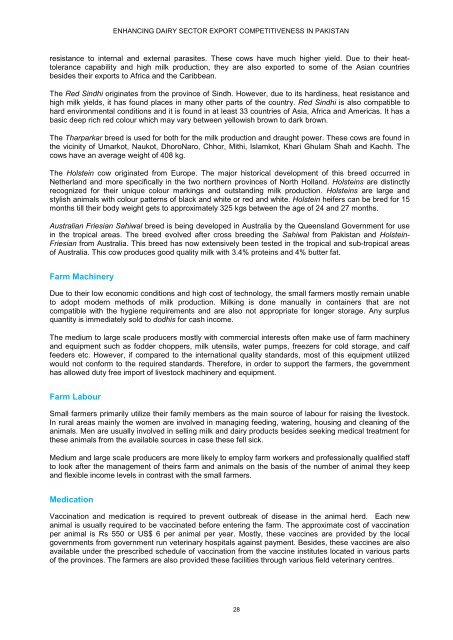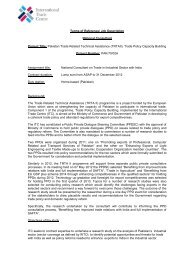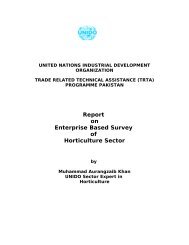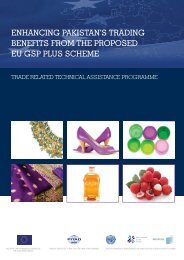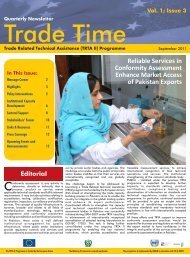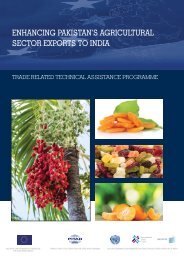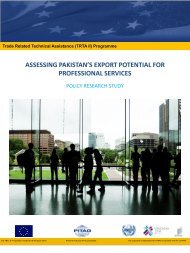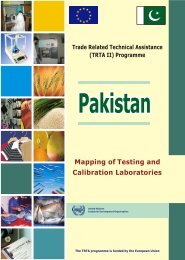Enhancing dairy sector export competitiveness - International Trade ...
Enhancing dairy sector export competitiveness - International Trade ...
Enhancing dairy sector export competitiveness - International Trade ...
Create successful ePaper yourself
Turn your PDF publications into a flip-book with our unique Google optimized e-Paper software.
ENHANCING DAIRY SECTOR EXPORT COMPETITIVENESS IN PAKISTANresistance to internal and external parasites. These cows have much higher yield. Due to their heattolerancecapability and high milk production, they are also <strong>export</strong>ed to some of the Asian countriesbesides their <strong>export</strong>s to Africa and the Caribbean.The Red Sindhi originates from the province of Sindh. However, due to its hardiness, heat resistance andhigh milk yields, it has found places in many other parts of the country. Red Sindhi is also compatible tohard environmental conditions and it is found in at least 33 countries of Asia, Africa and Americas. It has abasic deep rich red colour which may vary between yellowish brown to dark brown.The Tharparkar breed is used for both for the milk production and draught power. These cows are found inthe vicinity of Umarkot, Naukot, DhoroNaro, Chhor, Mithi, Islamkot, Khari Ghulam Shah and Kachh. Thecows have an average weight of 408 kg.The Holstein cow originated from Europe. The major historical development of this breed occurred inNetherland and more specifically in the two northern provinces of North Holland. Holsteins are distinctlyrecognized for their unique colour markings and outstanding milk production. Holsteins are large andstylish animals with colour patterns of black and white or red and white. Holstein heifers can be bred for 15months till their body weight gets to approximately 325 kgs between the age of 24 and 27 months.Australian Friesian Sahiwal breed is being developed in Australia by the Queensland Government for usein the tropical areas. The breed evolved after cross breeding the Sahiwal from Pakistan and Holstein-Friesian from Australia. This breed has now extensively been tested in the tropical and sub-tropical areasof Australia. This cow produces good quality milk with 3.4% proteins and 4% butter fat.Farm MachineryDue to their low economic conditions and high cost of technology, the small farmers mostly remain unableto adopt modern methods of milk production. Milking is done manually in containers that are notcompatible with the hygiene requirements and are also not appropriate for longer storage. Any surplusquantity is immediately sold to dodhis for cash income.The medium to large scale producers mostly with commercial interests often make use of farm machineryand equipment such as fodder choppers, milk utensils, water pumps, freezers for cold storage, and calffeeders etc. However, if compared to the international quality standards, most of this equipment utilizedwould not conform to the required standards. Therefore, in order to support the farmers, the governmenthas allowed duty free import of livestock machinery and equipment.Farm LabourSmall farmers primarily utilize their family members as the main source of labour for raising the livestock.In rural areas mainly the women are involved in managing feeding, watering, housing and cleaning of theanimals. Men are usually involved in selling milk and <strong>dairy</strong> products besides seeking medical treatment forthese animals from the available sources in case these fell sick.Medium and large scale producers are more likely to employ farm workers and professionally qualified staffto look after the management of theirs farm and animals on the basis of the number of animal they keepand flexible income levels in contrast with the small farmers.MedicationVaccination and medication is required to prevent outbreak of disease in the animal herd. Each newanimal is usually required to be vaccinated before entering the farm. The approximate cost of vaccinationper animal is Rs 550 or US$ 6 per animal per year. Mostly, these vaccines are provided by the localgovernments from government run veterinary hospitals against payment. Besides, these vaccines are alsoavailable under the prescribed schedule of vaccination from the vaccine institutes located in various partsof the provinces. The farmers are also provided these facilities through various field veterinary centres.28


